by Amy O’Hair
Why does your utility assert the smart meters they are installing are safe? In a sentence, they are protected by the very high limits the FCC has set for public exposure to radio-frequency (RF) radiation.
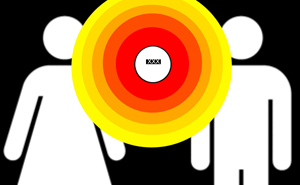 The RF from smart meters doesn’t exceed those limits, they say, therefore you can’t be harmed by it. Leaving aside the fact that smart meter RF pulses may in fact exceed those limits, let’s look at the FCC “guidelines.” What follows may surprise even those who think they understand the matter….
The RF from smart meters doesn’t exceed those limits, they say, therefore you can’t be harmed by it. Leaving aside the fact that smart meter RF pulses may in fact exceed those limits, let’s look at the FCC “guidelines.” What follows may surprise even those who think they understand the matter….
Who is the FCC? What do they do?
The United States Federal Communications Commission (FCC) was  never supposed to look after your health; it’s just not their job. They oversee allotting broadcast frequencies across the spectrum; mediate competition between service providers; keep communications up in emergencies; and slap the wrists of celebrities who curse on radio or peel off clothes on TV. The type of oversight they can exercise on “health” matters would be, for example, regulating the frequency of this human-implantable medical-records radio chip. Whether that chip will produce disease at the insertion site is none of their concern.
never supposed to look after your health; it’s just not their job. They oversee allotting broadcast frequencies across the spectrum; mediate competition between service providers; keep communications up in emergencies; and slap the wrists of celebrities who curse on radio or peel off clothes on TV. The type of oversight they can exercise on “health” matters would be, for example, regulating the frequency of this human-implantable medical-records radio chip. Whether that chip will produce disease at the insertion site is none of their concern.
Nonetheless, this is the government agency that has set the upper limit for how much radio-frequency (RF) radiation you can be exposed to from radio transmitters. How and when did they arrive at their “guidelines,” and what are those limits? The science is old, and the limits are sky-high.
How did we get here?
The history is a long and sordid one, beginning with the military’s 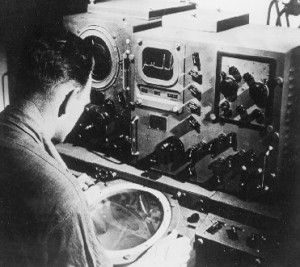 increasing use of radio technology, especially radar, in the 1950s. They didn’t want to kill or maim their soldiers and technicians outright, so they set out to find out what level of RF would injure them. The science that informed that assessment was anchored in the physics-based belief that unless you knocked an electron off a molecule inside a body—which is what x-rays or the radiation still streaming out of Fukushima can do—you couldn’t induce cancer or other long term harm.
increasing use of radio technology, especially radar, in the 1950s. They didn’t want to kill or maim their soldiers and technicians outright, so they set out to find out what level of RF would injure them. The science that informed that assessment was anchored in the physics-based belief that unless you knocked an electron off a molecule inside a body—which is what x-rays or the radiation still streaming out of Fukushima can do—you couldn’t induce cancer or other long term harm.
Radio-frequency radiation doesn’t have the energy to dislodge an electron, but it can heat human tissue–and do other things, as we’ll see. The military knew that heating wasn’t good, so they based the upper limit for human exposure on this threshold, called the “thermal effect.” FCC limits do protect you from being cooked by a psychopathic neighbor who wants to install an airport-grade radar transceiver on his roof aimed at your house. But, as it will be clear, this sort of guideline leaves a great deal to be desired in the realm of protecting public health from short-term “non-thermal” effects and long-term harm.
How do you measure RF?
Let’s start with the units used to measure RF fields in the environment. (Or you can skip ahead to rest of story.) When measuring radio frequency strength in terms of public exposure, you are looking for “power density”: that is how much radiating energy is hitting a surface (like your body’s surface). If you’ve read about RF, you may have seen figures like this: µW/cm². That means “micro-watts per square centimeter.” (‘Micro’ is represented by a Greek letter ‘mu’ µ and means ‘one millioneth’.)
That is to say, µW/cm² equals the number of millionths of a watt that are hitting a surface the size of a pinky fingernail. Some people use a different measurement: µW/m², microwatts per square meter, which is how many millionths of a watt are hitting a surface the size of a car rear window. (Your body surface is about 2 square meters total.)
Either unit can be used to represent a power density measurement. To compare the two units: 1 µW/cm² = 10,000 µW/m². That’s because you can fit ten thousand fingernails on a car rear window—10,000 square centimeters inside 1 square meter. Some people who are interested in small amounts of RF that can affect people use the second, smaller unit. It’s like if you were to describe how much water you drink a day, you’d say “32 ounces of water,” not “0.08 barrels of water” or “0.00125 cubic yards of water.” For sensitive measurements, use the fine-grained unit. Since biological effects have been observed down to low numbers of µW/m², that smaller unit is useful for talking about optimal human health conditions. Here’s a chart that lines up all the dozens of different units that electrical engineers use (yes, there are more). Here’s a calculator.
Power density is not the same as the power of the transmitter, but a stronger transmitter will create a larger power density. RF power density drops in intensity off the farther away you are from the transmitter, which is why, for example, people with smart meters near their beds are often the ones to complain of insomnia or waking with headaches.
 Congratulations, if you read and understood this section, you now know more about RF power density than 99.9% of the government officials who rubberstamp the wireless industry’s endless applications for more cell antennas. That’s enough on units for now–on with the story….
Congratulations, if you read and understood this section, you now know more about RF power density than 99.9% of the government officials who rubberstamp the wireless industry’s endless applications for more cell antennas. That’s enough on units for now–on with the story….
Low power is the norm for many wireless transmitters
A microwatt doesn’t seem like much, does it? But many radio-frequency transmissions, it turns out, don’t require a lot of power, depending on how far they must go before reaching a receiver. This is part of the reason  wireless communication is often a cheap way to transmit data; local transmitters can use small amounts of energy. And of course, there is no costly cable to lay. In many places now you can see wireless antennas on pole tops with no wired-in electricity, just a small solar panel for power. (Right: photo of SFPark.org antenna.) WiFi transmitters can reach hundreds of feet with just a third of a watt. Your cell phone can operate with a half- or even a quarter-watt. The older high-power cell phones used to go dead fast because they sucked a lot out of their batteries.
wireless communication is often a cheap way to transmit data; local transmitters can use small amounts of energy. And of course, there is no costly cable to lay. In many places now you can see wireless antennas on pole tops with no wired-in electricity, just a small solar panel for power. (Right: photo of SFPark.org antenna.) WiFi transmitters can reach hundreds of feet with just a third of a watt. Your cell phone can operate with a half- or even a quarter-watt. The older high-power cell phones used to go dead fast because they sucked a lot out of their batteries.
The FCC says the transmitter in a smart meter is supposed to be limited to 1 watt, but we’ve learned in the last year that the antenna pumps that up to an effective power of 2.5 watts. In addition, smart meters contain a capacitor or a battery that produces, at the moment of transmission, a burst of power. Think of flash units on cameras, which build up power in a capacitor, then release it all suddenly at the moment of the flash, making an intensely bright light, but only for a fraction of a second. We’d like to know how much power all that adds up to in the smart meter at the moment of the RF pulse, but smart meter manufacturers won’t release the specifications on their products or components.
That is not to say that wireless networks overall don’t use an enormous amount of power–they do. Cell antenna arrays can have huge power draws. But the RF transmitters which you come into close contact with every day are in general low power.
Low power RF doesn’t mean low biological effect
RF transmitters with small amounts of power have definite effects on bodies. 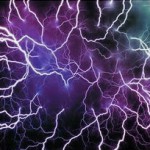 As biological organisms, we produce millions of tiny electrical signals internally—regulating our heart, our nerves, our cellular metabolism. In medicine, there are procedures that use RF with small amounts of power, to produce distinct changes in the body. This new treatment kills the malaria parasite with cellphone-strength RF (less than 1 watt), while the researchers blithely state that it shouldn’t be used for the head or torso area. This treatment for liver cancer uses low-power RF targeted to kill the tumor cells.
As biological organisms, we produce millions of tiny electrical signals internally—regulating our heart, our nerves, our cellular metabolism. In medicine, there are procedures that use RF with small amounts of power, to produce distinct changes in the body. This new treatment kills the malaria parasite with cellphone-strength RF (less than 1 watt), while the researchers blithely state that it shouldn’t be used for the head or torso area. This treatment for liver cancer uses low-power RF targeted to kill the tumor cells.
How could the FCC—whether or not they have doctors on staff (they don’t)—approve the RF used in medical devices, and then not wonder about what is happening in the bodies of the untold numbers of people being exposed to fields that are several thousand times stronger? They don’t wonder; it’s not their job.
Low power is enough power! Enough to: Damage the fetal brain. Make cells leaky. Adversely affect the heart rhythm. Damage sperm. Break DNA. Damage DNA. Increase glucose in the brain. Cut immunity. Dull memory. Stress genes. Worsen allergies. Weakened bones. More.
The FCC limits are a terrible joke
So, what are those sky-high limits on RF that the FCC has set? At the cell-phone and smart-meter range of frequencies, the FCC says that a field with an average power density of about 600 µW/cm² (6,000,000 µW/m²) is okay for humans for 30 minutes. Above that, your tissues begin to heat up, something everyone agrees isn’t good.
That’s average power density. I’m not sure I can emphasize this point enough: inside that 30 minutes, there could be a great number of peaks at much higher levels—just as long as the average reading comes out below that stipulated limit.
Time-averaging RF erases peak spikes
With modern technologies which can produce a transmission pattern of millisecond pulses–and all smart meters and cell phones do this–a device can emit pulses which at their peak far, far exceed the FCC upper limit, yet when averaged will appear to comply with it, even be far below it. One EMF technician associated with Stop Smart Meters! during his preliminary data gathering has recorded a peak pulse in excess of 20,000 µW/cm² (=200W/m²) and observed ones far higher than this.
Time-averaging is how PG&E hides the true peak levels of RF pulses produced by their smart meters. This chart below shows the stark difference between averaged (red) and actual (blue) RF levels measured from a similar smart meter in southern California (chart courtesy EMF&RF Solutions, www.EMFRF.com).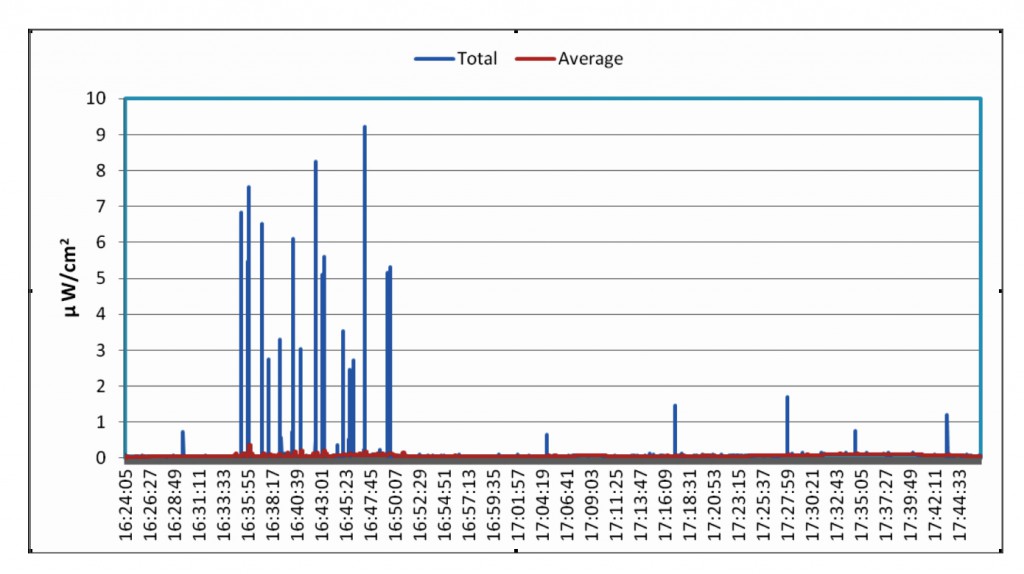 I checked in with an associate who has a PhD in electrical engineering: how many high peaks could you have, and end up with a low average? We invented an example and calculated the average level using information from the FCC’s own document addressing the matter. A thirty-minute period could contain one hundred (100) 5-millisecond pulses (at 900MHz) (duty cycle=0.02%), each pulse a whopping 100,000 µW/cm² each (the big unit), and the averaged level could be calculated to be around 28 µW/cm². The device’s maker could then claim this constituted only about “5% of FCC limits.” But a person standing in that field would actually be subjected to very high bursts of RF energy, which have been shown to have biological effects.
I checked in with an associate who has a PhD in electrical engineering: how many high peaks could you have, and end up with a low average? We invented an example and calculated the average level using information from the FCC’s own document addressing the matter. A thirty-minute period could contain one hundred (100) 5-millisecond pulses (at 900MHz) (duty cycle=0.02%), each pulse a whopping 100,000 µW/cm² each (the big unit), and the averaged level could be calculated to be around 28 µW/cm². The device’s maker could then claim this constituted only about “5% of FCC limits.” But a person standing in that field would actually be subjected to very high bursts of RF energy, which have been shown to have biological effects.
This engineer then set out to find what the maximum allowable peak pulse is, according to FCC standards, and particular, what power density would a smart meter pulse be permitted to peak at? Although there is a reference to a “guideline” of 4,000µW/cm² as determined by ANSI/IEEE C95.1-1992 in the Sage Report discussion on peak power limits, we couldn’t find explicit limits stated anywhere else. Here is a recognized dangerous substance, and there is effectually NO regulation on the upper limit of peak pulses the public is exposed to.
 Are you an electrical engineer who can tell us what that upper limit on the peak pulse of a PG&E smart meter is? What is allowable? Calculated? Measured? We want to know. Write info@StopSmartMeters.org, and if you can back up your claim, Stop Smart Meters! will consider a guest post where you can tell readers what you know.
Are you an electrical engineer who can tell us what that upper limit on the peak pulse of a PG&E smart meter is? What is allowable? Calculated? Measured? We want to know. Write info@StopSmartMeters.org, and if you can back up your claim, Stop Smart Meters! will consider a guest post where you can tell readers what you know.
The time-averaging issue shows up an important point: patterns of exposure—like these sharp spikes—are not part of the FCC’s considerations concerning the effects of RF on humans. This is a serious oversight, and any revision of the FCC guidelines should address this as well.
The best analogy to these spikes of RF energy is a strobe light. Using the same energy as a low-watt bulb, a strobe light produces very intense millisecond pulses of light, several per second, and has been shown to adversely affect the brain, inducing seizures in some people. RF is an electromagnetic energy like light, but one that penetrates into the surface of our bodies. (This paper by Karl Maret, MD, has excellent references on pulsed RF effects on humans.)
Many observers trying to reckon with the sheer number and consistency of smart-meter health complaints have seriously wondered whether this particular under-regulated and unaccounted-for factor might be at the heart of the harm done by wireless utility meters.
Many questions are utterly unaddressed by FCC guidelines
Smart-meter pulses aside for a moment, there are many other exposure issues that lay outside the FCC guidelines. Why isn’t there an effective limit on the maximum peak level? How much time should pass between 30-minute stints at that high level?
 How much total RF are we getting from all the various RF sources in our lives? What about the vulnerable among us? Pregnant women? Children?
How much total RF are we getting from all the various RF sources in our lives? What about the vulnerable among us? Pregnant women? Children?
What is the biological effect of a low dose over a long period? Over a lifetime? This is a much better description of the modern public exposure pattern than the brief exposures that radar technicians of the 1950s had to contend with.
I admit it is very unlikely that the FCC will address these kinds of questions in the near future. Nor are they passing the matter to any other agency which might have authority regarding public health, such as the FDA or the EPA. Formulation of the original standards could not possibly have foreseen how the vast majority of non-military citizens would end up spending all day, or nearly all day, in a substantial RF field.
RF exposures have changed radically; the guidelines have not
There has been no review of the matter at the FCC despite massive changes in technology and consumer behavior. Established in the 1970s based on 1950s science, and firmed up in the Telecommunications Act (TCA) of 1996, (just as cellular networks were going up), the guidelines have not been reviewed since then—even as usage patterns have changed drastically. For example, for purposes of the Interphone Study (2004)–which despite massive flaws is often cited by those who dismiss cell-phone cancer risk–a “regular user” was someone who used a cell phone at least once a week. Today many users are on their phones two or three hours a day, equaling 800 – 1200 minutes a week—while also being exposed to numerous other RF sources in the environment, like WiFi, cordless phones, antennas, GPS devices, and smart meters. Smartphones produce nearly constant personal exposures for users via automated network connections.
Has the FCC followed up, as remarkable technological changes have resulted in substantial increases in personal RF exposure? No. They haven’t  re-considered the matter in decades. Basic field data is largely untracked. They only measure RF emissions at a tiny fraction of wireless installations—they don’t have the staff to investigate. The same goes for the RF levels you get in your own home from consumer devices like cordless phones. Additionally, it is the EPA who is supposed to regularly assess overall pollution levels in the environment, but they haven’t touched RF for four decades since an assessment in 1979.
re-considered the matter in decades. Basic field data is largely untracked. They only measure RF emissions at a tiny fraction of wireless installations—they don’t have the staff to investigate. The same goes for the RF levels you get in your own home from consumer devices like cordless phones. Additionally, it is the EPA who is supposed to regularly assess overall pollution levels in the environment, but they haven’t touched RF for four decades since an assessment in 1979.
Some who support wireless proliferation say RF transmitters have been with us since the first days of radio, when a few high-power transmitters dotted the country. But this misses the vital point: at no point in the past have so many people had multiple RF and microwave transmitters so close to their bodies–right next to their heads, in most cases; there is no science to assure the safety of such close, long-term contact.
Last year in May 2011, the IARC, part of the World Health Organization, finally decided, after years of wrangling, that RF radiation can possibly cause cancer (Class 2B). This decision was arrived at even though many of their members have heavy-duty wireless industry ties and have not been known for precautionary vigilance in protection of public health.
Did this new—though conservative—designation provoke the FCC to review its guidelines? No. You won’t find any changes made in their safety guidelines in light of this landmark. There is nothing on the FCC website regarding this important announcement.
Why aren’t these FCC limits sufficient to protect us from harm?
RF effects that fall below that FCC limit are called “non-thermal.” But it turns out “non-thermal” does not mean harmless, it just means not cooking you. Many things happen to your cellular metabolism, cardiac system, and neurological system, before you get up to the heating point. (See above for more info.)
 One of the more disturbing effects is a marked increase in permeability in the blood-brain barrier (BBB). (Here is another study.) This vital cellular gatekeeper protects your precious and otherwise vulnerable neocortex from being flooded with the various microscopic gunk you breathe and eat and touch everyday. Do I need to mention how important your brain is?
One of the more disturbing effects is a marked increase in permeability in the blood-brain barrier (BBB). (Here is another study.) This vital cellular gatekeeper protects your precious and otherwise vulnerable neocortex from being flooded with the various microscopic gunk you breathe and eat and touch everyday. Do I need to mention how important your brain is?
RF has other effects on us, and cancer is among them. Admittedly no one wants cancer—but it may be that in the long run, a million people with chronic ill health over several bodily systems may be a more serious public-health problem than a hundred people with cancer. So searching for definitive cancer effects from RF (though evidence for that is clear) may actually be distracting regulators from reckoning with the larger picture: every person in modern society—from conception onward—is exposed to unprecedented levels of RF, and that may represent the true burden of disease, which leaves cancer as the mere iceberg-tip.
What is a biologically based RF limit for humans?
Who else besides the FCC has addressed the matter of how much RF is all right for humans? Some scientists have approached the matter by asking how much RF radiation it takes to produce adverse effects in humans. Using observed biological effects–in the test tube and in animals–as well as taking into account what happens in populations of humans who are exposed to things like cell antennas, they have arrived at very different conclusions about how much we should be exposed to.
How different is a biologically based RF limit from the FCC limit? About ten thousand times different. That’s about the size of the spread between the FCC “guidelines” and the level that scientists tracking the actual effects on biological life recommend for human exposure. Example: The Bioinitiative Report recommends 0.1 µW/cm² (big unit) for an outdoor maximum. (See links below for other biologically based guidelines.) To repeat: FCC limit: 600 to 1000 µW/cm² vs Bioinitiative: 0.1 µW/cm². Realistically speaking, this massive gap isn’t one that can be bridged in the near future. The wireless industry has their back covered by these government regulations, leaving the public uninformed and unprotected.
But cracks are showing. Last year San Francisco passed a cell phone right-to-know 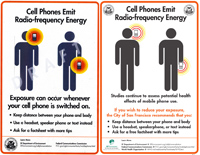 ordinance—but it was promptly silenced by a lawsuit from the Cellular Telecommunications Industry (CTIA), then shot down by a federal judge who compared it to warning people about UFOs. However, there is slow progress. Last week, the Israeli Knesset passed a law requiring labels on all cell phones warning users about cancer, and the vulnerability of children.
ordinance—but it was promptly silenced by a lawsuit from the Cellular Telecommunications Industry (CTIA), then shot down by a federal judge who compared it to warning people about UFOs. However, there is slow progress. Last week, the Israeli Knesset passed a law requiring labels on all cell phones warning users about cancer, and the vulnerability of children.
But the stakes are high for maintaining RF limits where they are now—unprotective, unreviewed, barely enforced, and sky-high. There are now more cell-phone accounts in the U.S. than actual citizens. The proceeds–$165Billion in the US in 2011–are immense profits for the industry players. On one hand, the bottomless coffers of the wireless industry assure them of compliance from politicians who are ever in need of money, and on the other hand, the industry gets little pushback from the general public, who are largely distracted and entranced with consumer techno-gizmos.
Under federal law, your city cannot prohibit antennas on the grounds of health or environmental damage
Complicating the matter of regulation is the fact that, by law, no U.S. city, county, or state can object to any telecommunications facility (e.g. cell antenna) on the grounds of real or perceived health damage. If this is news to you, I am sorry. I was shocked myself to find this out. This was written into the Telecommunications Act (TCA) of 1996, § 704, signed into law by President Clinton, and remains the law of the land. Here’s a summary about the issue from the FCC. Here’s some legal analysis from a law review. And here’s some commentary from B. Blake Levitt, “The Struggle for Local Control.”
Every elected or appointed local public representative is thus prevented from acting to protect public health. But the public can–and should–still speak out against public harm from wireless facilities.
So you can be made sick, or sleepless, or get cancer, from your local cell phone tower, and there is nothing, as of now, you can do to legally stop it or get compensation for your injury. You can’t sue the industry, and you can’t sue your city, state, or federal government, at least not on the grounds of disease. This particular clause is an outright theft of local governmental power to protect constituents, and must be overturned.
Perhaps here too, there are changes mounting. This week Greenwich CT pushed back on the siting of cell towers near concentrations of children, while explicitly citing health concerns as the rationale.
What can we do?
Government regulation is a long way behind the science, and even further behind the so-called “precautionary principle”—the basic notion of protecting people from a pollutant until safe levels have been assessed. The clause quashing objections on health grounds in the TCA (above) leads this citizen to wonder whether the harm to the public from wireless installations was actually fully anticipated by our government and the big-business interests who pushed the bill through in the 1990s. Why else would they have essentially muzzled any effective objections by people or communities trying to protect their health and life? (You are allowed to object on the grounds of ugliness, but now the industry is going to great pains to hide antennas and make them disappear visually.)
Invisible and silent, RF can be scary to contemplate because it can’t be sensed by most people. Millions use a cell phone all day with no way to assess their total exposure, or sit next to a cordless phone base or WiFi unit without even being aware that it is a constant source of high levels of pulsed RF.
The current mass addiction to smartphone connectivity has been compared to cigarette smoking. But even in the heyday of cigarettes, 25% of people refused to smoke—perhaps because there was always immediate sensory feedback about it—the hot stinky smoke, eyes stinging, coughs, bad breath. Anyone can smell smoke, but very few people can sense RF or its effects right away.
Having a device to measure RF is the only way for most people to know quickly that they are in the presence of RF, and how much. But it’s tedious and somewhat antisocial to always be whipping out a little meter to find out how much pollution is in the air around you (having done it for a while now myself).
But that doesn’t leave you helpless. Even without a measuring device, there are still very clear things you can do to cut your personal exposure:
- Ditch the cordless phone and get a wired landline;
- Cut your total cell-phone use and configure your phone to avoid automated connections;
- Disable your WiFi unit and wire your internet connection;
- And, of course, refuse to allow smart meters on your home or in your neighborhood.
Changing your exposure to these four devices can make a big difference in your total exposure; better sleep can be an immediate benefit for some. However, for electro-sensitive people, these measures are often insufficient, and a normal life is very difficult.
Radio-frequency radiation is a matter of public health
Individual precautions are not enough, because the very nature of RF is that it penetrates bodies and structures—ultimately, it doesn’t respect your “personal choices.” One person’s actions are not enough to address the issue for EMF-sensitive persons who suffer with very low exposures, and for the vulnerable among us like children, pregnant women, and the aged. We’ve documented how even those working in high tech can become sensitized over time. Poorly regulated RF has public health consequences.
The lack of meaningful regulation means you may not have any way to avoid the RF radiation you are exposed to at work, or from your local cell phone antenna or your neighbors’ smart meters, or on public transportation. There are numerous situations where RF exposure is in no way a matter of “personal choice.”
“Personal choice” in consumer devices has lead to massive involuntary public exposure from ever-proliferating antenna arrays near homes, schools, and public places–like the DAS antennas currently going up in residential neighborhoods. Mouthing off about “personal choice” has been the devious way that PG&E and other utilities have avoided facing up to the effects their meters have on whole communities, the general public, and those exposed to large banks of smart meters.
While one can choose personal self-protection, it is simply not enough.
The FCC guidelines for radio-frequency emissions must be changed to protect the public from both harmful incidental exposures and personal consumer-device exposures.
There are people working to institute a review of these outdated guidelines. There are petitions and blogs. There are excellent groups working for cell-phone warnings and public awareness. There are even people like me roaming around measuring RF in their communities and talking to strangers. There isn’t one single answer.
Please read the links below and consider some actions. First and foremost, help yourself or someone you love learn how to avoid unnecessary RF exposure. Talk to people you know–most people have no idea there is even an issue, so this is a powerful way to change awareness. Write a letter or email to your legislator. Become a member of a coalition fighting for public awareness. Show up and speak at a public hearing on siting cell antennas. Don’t just sit there and get dosed.
[PDF of this article now available here.]
_____________________________________________________
Amy O’Hair has been researching and measuring smart meters and RF for the past year, and posting videos here: youtube.com/ThisIrradiatedLife. Twitter: @vegosapien
_____________________________________________________
LINKS (also check “external links” in our top menu):
Groups and individuals working for RF awareness and better regulation:
- EMF Safety Network. http://EMFSafetyNetwork.org
- Ecological Options Network. http://Eon3emfblog.net
- Center for Electrosmog Prevention. http://electrosmogprevention.org/
- Center for Safer Wireless. http://centerforsaferwireless.org/
- Dr. Magda Havas. http://www.magdahavas.com
- Electromagnetic Health. http://electromagnetichealth.org/
- EMR Policy Institute. http://www.emrpolicy.org/index.htm
- Citizens for Safe Technology. http://citizensforsafetechnology.org/
- Electrical Pollution Solutions. http://www.electricalpollution.com/
- ElectroSensitivity UK. http://www.es-uk.info/info/index.asp
- MORE.
Summaries, accounts, and overviews of EMF/RF regulation:
- Silent Wireless Spring, Arthur Firstenberg of www.cellphonetaskforce.org
http://www.cellphonetaskforce.org/wp-content/uploads/2011/06/silent.pdf - Hour-long talk by Alastair Phillips of Powerwatch.org.uk. Full of information. http://www.youtube.com/watch?v=NYV8YWESt_Y
- “Is a Wireless World a Health Place?” One-hour radio talk with Deborah Kopald of WirelessRightToKnow.com. http://www.greenstreetradio.com/122011.html
- “Full Signal” a movie detailing public RF exposures. See the trailer: http://www.youtube.com/watch?v=5_dihi0T5bM (click for pay-to-watch)
- News report from KTVU Oakland, demonstrating how most U.S. household devices exceed RF standards in Europe. http://www.ktvu.com/videos/news/special-report-mobile-devices-emitting-microwave/vCyJq/
Biologically based standards, proposals, and organizations:
- Bioinitiative Report. http://www.bioinitiative.org/report/index.htm
- International Commission for Electromagnetic Safety (ICEMS) http://www.icems.eu/
- International Electro-Magnetic Fields Alliance (IEMFA) http://international-emf-alliance.org/
- Seletun Statement. http://www.iemfa.org/index.php/publications/seletun-resolution
- Council of Europe
http://assembly.coe.int/Documents/WorkingDocs/Doc11/ EDOC12608.pdf - 15 Reasons for Concerns (re Interphone Study). http://www.radiationresearch.org/pdfs/reasons_us.pdf
- Comparison of various international guidelines. http://emfwise.com/emf-safety-standards.php
- Cell Phone Right to Know Act. http://www.electricalpollution.com/CellphoneRightToKnowAct.html
Find your Legislator in CA. http://www.leginfo.ca.gov/yourleg.html
Cell phones and health damage:
- Disconnect, the book. http://www.disconnectbook.com/
- Disconnect, the film. http://www.disconnectfilm.com/ There is a showing in Berkeley 14 March.
- California Brain Tumor Association http://www.cabta.org/CABTA/CABTA.html
- Investigative report from Consumers Digest http://www.consumersdigest.com/electronics/a-bad-connection-cellphone-radiation-health-risks
- Pregnant Women. http://www.prweb.com/releases/2012/2/prweb9153096.htm
- Call for Improved Standards. http://www.decodedscience.com/underestimation-of-cell-phone-radiation-a-call-for-improving-safety-standards/4402
- Safer Phone Zone. http://www.saferphonezone.com/
- More information on cell phone radiation
Personal shielding and protection:
- Handy Fashions. Chic Euro-style. http://www.handy-fashions.com/
- Less EMF. http://lessemf.com
Find the cell antennas near you: http://www.antennasearch.com/

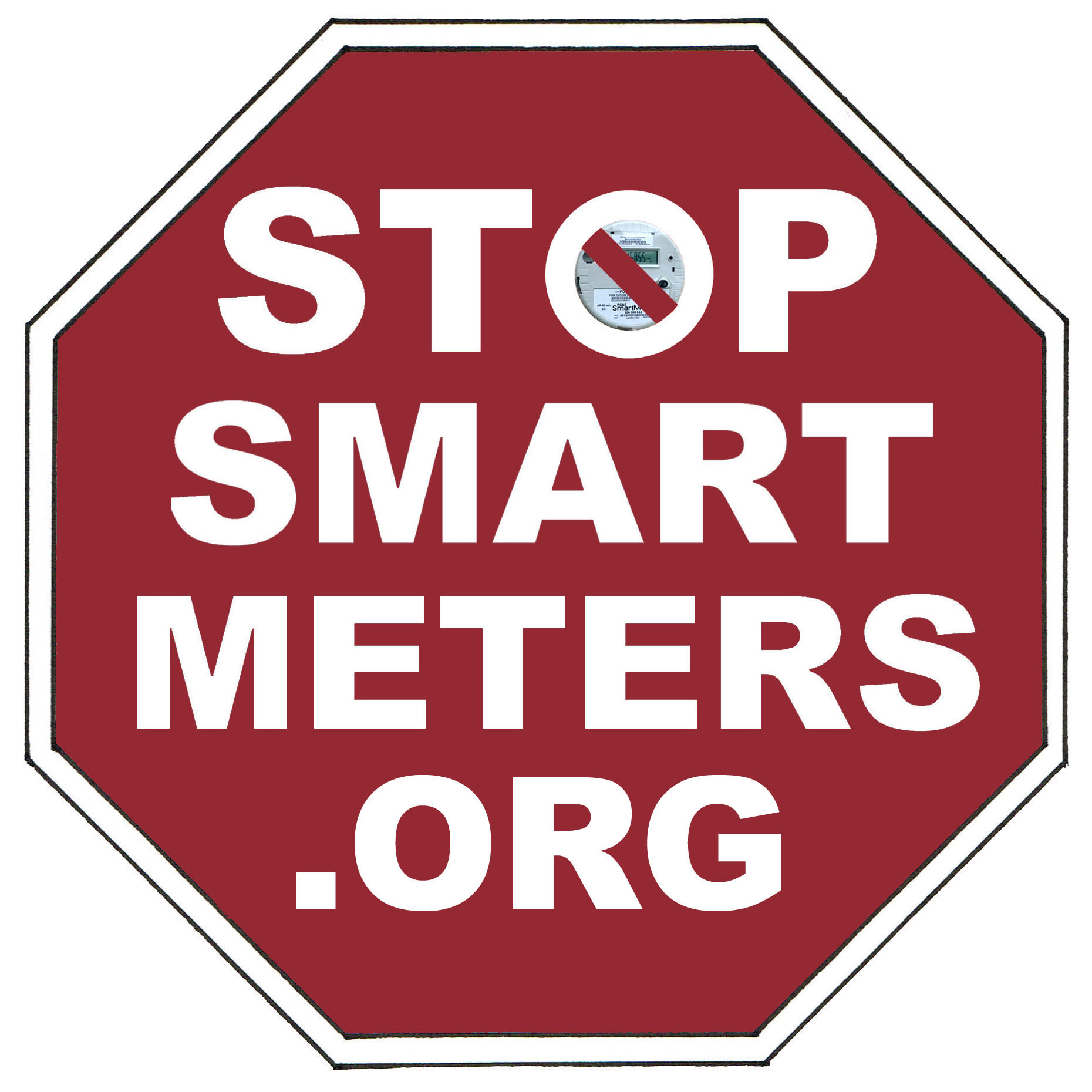
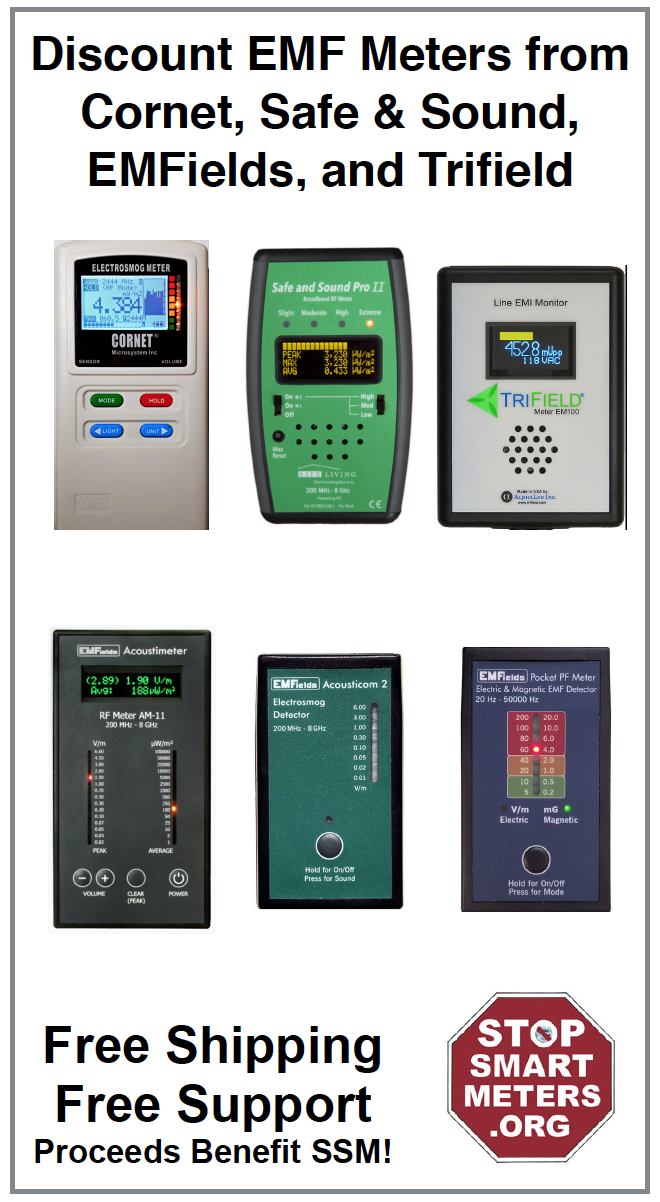
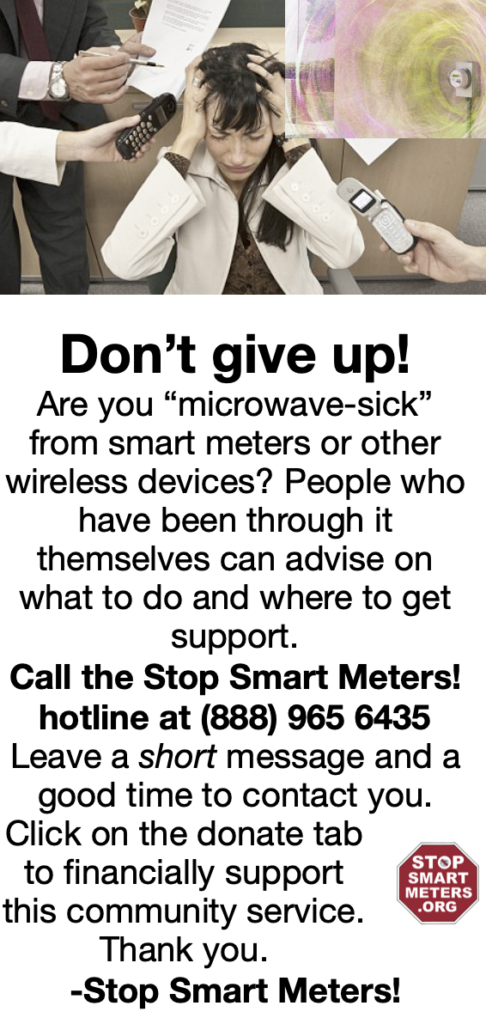
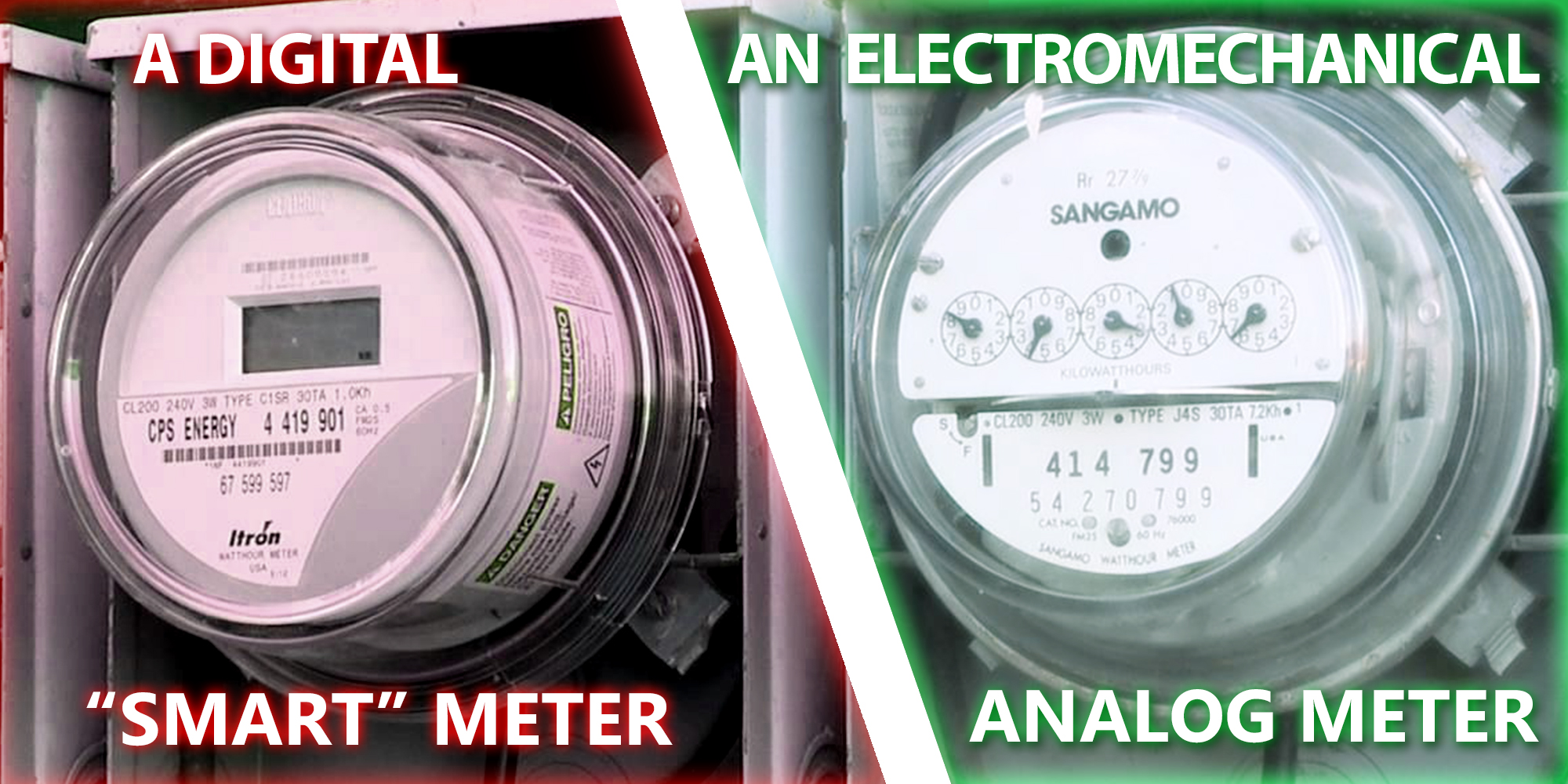

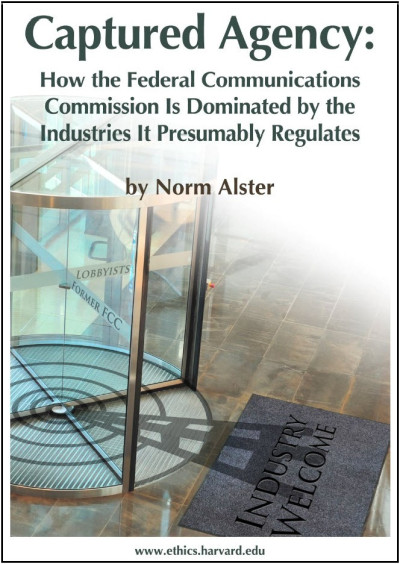


Great article! Hopefully it goes viral!
I would like to add a video of the late Dr. Ted Litovitz, EMR reseacher and physicist. Too much of anything, effecting us on a biological level, can be a poison.
http://www.stayonthetruth.com/electromagnetic-fields—dr-ted-litovitz.php
Well done research and I agree with much that was said about FCC radiated emissions levels for Class B and class A devices, however……..
why do groups like yours focus on smartmeters! this is silly! what about your cellphones that you hold on your head for hours a day which does transmit around 2 watts at higher power when coverage is poor? what about the bluetooth and Zigbee transceivers locked onto your ear, in your car and in devices all around you! what about all the wi-fi devices, routers, smart TV’s Blu Ray players, XBox, PS2, etc etc!! and don’t forget the beast of all RF microwave radiation in the home that dwarfs all these in power spectral density the microwave!!! do you stand next to the microwave when your heating water? you wouldn’t if you would see it operating with a spectrum analyzer!
if one were to take a spectrum analyzer (device used to measure RF power levels) into a home with the correct measurement antennae it would light up between 700Mhz to around 5Ghz.
worst of all that is misleading about this article is that the three radios mentioned in the smart meter: the GSM is a typical cell phone radio, the Zigbee is in several appliances, printers etc in your home and the lowest power radio of them all is the ~900 Mhz mesh radio in the smartmeter which operates in an FCC licensed band which means it has to test and be proven in an anechoic chamber to operate at power levels less than all other FCC class B devices essentially home consumer devices).
I agree with being an avid consumer and I believe we are bombarded with waaaay too much RF and I believe the FCC never considered the proliferation of RF devices when they set the original Class A and B limits but as an electrical engineer and as an RF designer and as a former smartmeter radio designer (to which i have zero allegiance) get the facts right. tell the whole story, don’t mislead, be accurate because there truly is a danger but not where you are looking the smartmeter is just an incremental adder to the bigger equation.
and if you really want to know the danger of the electric smart meter look at the house fires! there is definitely a problem there!
I do own equipment to measure. Not much attention is paid towards the energized wiring attached to the smart meter. Some homes have out of code wiring producing high electric or magnetic fields. The chronic exposure can be much higher when this happens.
All wireless can be mitigated by unplugging it or turning it off, unlike the dumb meter.
I have found that the most damage occurs when sleep is interrupted. Smart meters cause this problem. The mechanism is now known.
People that don’t take my advice suffer and then die. I picture the poor guy that died a horrible death of cancer. He scoffed at the idea that wireless was a problem. Ironically his favorite place to sit was a hotspot created by a cordless phone and wifi router. The smart meter was never removed even though he was warned multiple times. May the fool rest in peace.
Thank you, Amy. That is a well-written, comprehensive article that certainly woke up my brain this morning!
I dreaded researching this when I first realized that “smart” meters were probably not a good idea. I know that’s putting it mildly, but, when I first got the bland, vague flyer from my electric company, which made NO MENTION of safety, btw, I thought, “Well, that’s probably going to result in a lot less pollution!” Then, I started hearing little hackability rumblings, and I thought, “Oh, those are just privacy nuts!” Then, a saw postings about “smart” meters impacting the health of humans, and that’s when I started to take notice.
Next thing I knew, I had to study radiation and electromagnetic fields! So, good times. Now, our family has gone pretty much wifi-free, except for a couple of ancient flip phones. We’re not only NOT keeping up with the Joneses – the Joneses are aghast! We’ve replaced the microwave with a convection oven, replaced the cordless phones with an answering machine and regular land lines, switched the modem to “wired connection,” and keep our cell phones as far away from us as possible day and night.
We don’t have a “smart” meter, but some of the neighbors do. I totally agree that we must all work together to get the FCC to update their guidelines, so I’ll be dedicating an entire page of my website to your info, and, when I get three seconds, to trying to change those standards. And I so appreciate your taking the time to spell it out for your readers. I especially benefitted from the explanation about the difference between the centimeter squared and the meter squared. You definitely see both units if you study this for any length of time.
I did want to add that the EPA itself admits that the FCC doesn’t cover non-thermal effects. I found that out in the “Naperville Smart Meter Alert” (http://napervillesmartmeterawareness.org/wp-content/uploads/2011/01/NSGI-SummaryRisks-09-20-2011.pdf), which is just a good all-around reference anyway. We include it in our “‘Smart’ Meter Survival Kits” we hand out at city council and other meetings around the state (http://www.stopsmartmetersgeorgia.org/smartmetersurvivalkit.html).
Also, the study that the power companies cite, the CCST Report, that they say proves how safe these devices are, vis-a-vis the FCC guidelines, is next to useless. Just one example: That report considers the placement of a “smart” meter electric meter on the side of the home, e. g., on the wall outside of a bedroom, kitchen, or living room, as an unusual placement! The same goes for putting a group of “smart” meters together, as would very commonly be seen at an apartment complex. So, the two MOST COMMON PLACEMENTS are considered to be out of the ordinary by the electric companies “safety report.” I don’t know how they sleep at night, to tell you the truth. Perhaps next to a “dumb” meter!
At any rate, thanks again, and I will be posting this info far and wide, because it is quite clear and compelling. Once again, StopSmartMeters is at the forefront of keeping people all over the world safe and sound, and truly smart!
I just left a comment about your article at the Savannah Morning News. I believe that last year, they won an award for best newspaper in Georgia, so it is a much-visited site.
Here’s the comment, and I would invite any and all StopSmartMeter.org visitors to leave their own comments there. We need more informed views to populate that section! Here’s the link: http://savannahnow.com/news/2012-03-09/smart-meter-opt-out-moves-forward.
StopSmartMeters.org has a wonderful article today, by Amy O’Hair, on the FCC’s lack of guidelines on non-thermal radiation. No matter what your level of knowledge is on RF, you will benefit from reading it, if you’re interested in protecting you and your family from its affects.
Here are some highlights:
“Low power RF doesn’t mean low biological effect”
“RF transmitters with small amounts of power have definite effects on bodies. As biological organisms, we produce millions of tiny electrical signals internally—regulating our heart, our nerves, our cellular metabolism. In medicine, there are procedures that use RF with small amounts of power, to produce distinct changes in the body. This new treatment kills the malaria parasite with cellphone-strength RF (less than 1 watt), while the researchers blithely state that it shouldn’t be used for the head or torso area. This treatment for liver cancer uses low-power RF targeted to kill the tumor cells.
“How could the FCC—whether or not they have doctors on staff (they don’t)—approve the RF used in medical devices, and then not wonder about what is happening in the bodies of the untold numbers of people being exposed to fields that are several thousand times stronger? They don’t wonder; it’s not their job.
“Low power is enough power! Enough to: Damage the fetal brain. Make cells leaky. Adversely affect the heart rhythm. Damage sperm. Break DNA. Damage DNA. Increase glucose in the brain. Cut immunity. Dull memory. Stress genes. Worsen allergies. Weakened bones. More. [Those are all links that will take you to the research.]
“The FCC limits are a terrible joke”
Amy goes on to say that, whereas the power companies say that they are staying within the FCC guidelines (600 microwatts per square centimeter), they’re only able to do that because of something called “time-averaging.”
Through time averaging, one is able to hide the fact that spikes can occur that go high above the FCC limit.
“With modern technologies which can produce a transmission pattern of millisecond pulses–and all smart meters and cell phones do this–a device can emit pulses which at their peak far, far exceed the FCC upper limit, yet when averaged will appear to comply with it, even be far below it. One EMF technician associated with Stop Smart Meters! during his preliminary data gathering has recorded a peak pulse in excess of 20,000 µW/cm² (=200W/m²) and observed ones far higher than this.”
https://stopsmartmeters.org/2012/03/09/a-primer-on-the-fcc-guidelines-for-the-smart-meter-age/#comment-37431
So, it’s fine and dandy to bombast on an internet comment section. It’s another to allow yourself and your family to be exposed to constant, dangerous radiation, that in some instances is less than one foot from your child’s head for eight hours a night. That is no laughing matter. I suggest anyone who has not researched “smart” meters before spouting off about them go do the legwork that others have done, in order to protect the citizens of Georgia, and, in Amy’s case, people around the world. Then come back and honestly let us know what you’ve found.
My evolving understanding of the wifi smart meter is that analog meters functioned perfectly and safely and involved employment of meter readers,Smart meters allows for the utilities to lay off the meter readingemployees and that saves the utilities money However, the smart meters cost billions of dollars which the rate payers nor utility shareholders will be forced to pay in higher monthly utility bills The smart meters unlike the perfectly functioning analog meters have many functional problems such as misreading the amount of energy consumed as higher than it actually was but leaving no basis for the rate payer to prove what he knows to be true; the end result is frustration and wasting of time of rate payers while utilities gain financially from the malfunction.
There are reports of spontaneous fires caused by the smart meters, and an inability of the smart meters to secure sensitive customer information; I saw there was an apparent requirement for utilities to correct this or perhaps to just lessen the problem. The jewel in the crown of smart meters relative to the completely safe and in fact by comparison actually smart analog meters is that the so named smart meters, although functionally problematic as utility meters do have a surprisingly smart capacity. Though surely not intended as such, smart meters act as super smart high tech anti-personnel or anti-population weaponry!! From what I have read of the health effects that can and should be expected if these devices are successfully deployed -and that is what is going on as I write–the populations expoed to the devices, which we may designate as the customers of the private utility monopolies, or ratepayers, will experience a huge increase in the incidence of chronic illness as well as curtailment of their lifespan. In other words the captive utility customer population exposed to the radiations from the devices over a long period will slowly and gradually in large numbers sicken and become chronically ill for some period before dying prematurely relative to when they could be expected to die if the analog meters were retained.
A slow mass curtailment of the lifespan of the California utility companies will occur while the CPUC mandates that those rate payers must pay the billions of dollars in costs incurred in replacing the safe smart functioning analog meters with meters that are smart only as slow mass population kill machines. Extraordinary when you think about it. Normally, one might view the intentional deployment of devices that will curtail the lifespan of the people exposed to them as mass murder; I do not know what the correct term is for this when the devices are utility meters and the CPUC commission, the gatekeeper to protect the public interest and safety from utility monopoly actions has disregarded the expert opinion and comprehensive reports created Cindy Sage, an expert in the very field of the new devices’ technology and presented to the commission to inform them of the health dangers posed by the wifi smart meter devices. The mission statement of the CPUC clearly mandates that the commission act in the public interest and safety and amazingly even specifies protecting the utility customers from imposition of unsafe machinery infrastructure.
The truth is, no matter how plausibly legal the commissioners calculated their designation that the wifi smart meter devices are safe, they in reality had in their possession compelling comprehensive documentation that the devices are not safe. The devices are not safe.
In January 2012 an extraordinary thing occurred! The AMERICAN ACADEMY OF ENVIRONMENTAL MEDICINE wrote a letter to the CPUC expressing the position taken by that organization whose field in fact encompasses exactly the scope of ill health potential of the technology used in the wifi smart meter devices; their unequivocal contention is that the devices are harmful to human health and should not be deployed and those already installed on people’s homes should be removed. Perhaps the AAEM was aware that the CPUC had ignored invaluable data presented by Cindy Sage and hesitated to
include material that migh overwhelm the commissioners if that was their problem in failing to address the Sage Report; in any case, the letter from the AAEM specified that they would provide documentation Upon Request. The AAEM action in informing the commission of the AAEM expert opinion based on the most current scientific research available was a great gift to the people of California and to the agency, the CPUC, mandated to protect their interest and safety. What did the CPUC commission do? Did they contact the AAEM, thank them for their generous letter and ASK FOR THE DOCUMENTATION that the letter indicated would be made available upon request? NO NO NO.
Amazingly, the CPUC disregarded and ignored the Expert opinion of the AAEM and the CPUC DID NOT REQUEST THE DOCUMENTATION THAT EVIDENCED THE FACT THAT THE WIFI SMART METER DEVICES USED A TECHNOLOGY HARMFUL TO HUMAN AND ANIMAL HEALTH AND ARE TOO DANGEROUS TO DEPLOY ON PEOPLE’S DWELLINGS.
Anyone, minus moral imbeciles, who looks at the evidence can see that the CPUC commission acted in a way that is CLEARLY inimical to the interests of the public and inimical to what concern for the utility monopoly customers safety would mandate; the CPUC by falsely claiming that the dangerously harmful devices are safe when they had had placed at their disposal clear and compelling evidence that the best scientific research available indicates that the devices are harmful, acted
in a manner clearly contradictory and in contradiction to the clear mandate of the CPUC agency clearly stated in the agencies Mission Statement; that mission statement is the first thing you see if you go to the CPUC website. California is now in a state of crisis. Devices are being deployed that under the guise of peoorly expensive poorly performing utility meters that will act as slow kill weaponry which can be reasonably expected to greatly increase the incidence of chronic illness in the utility customer populations with long term exposure, followed by premature death or a curtailed lifespan; i.e. slow murder.
Thanks a lot CPUC!
It is hard, nigh impossible, for me to view the actions of the CPUC commissioners whose mandate is to protect the public’s interest and safety from actions of private monopoly utilities, as other than the actions of five morally insane people. The public interest is clearly not-NOT-safe in their hands.
Ultimately, were reason to prevail, this episode of deployment of weaponlike utility meters indicates there is no place for private utilities in California; but for now we must reckon with the fact that these utilities are DEPLOYING devices that will harm our health.
You are correct, the SmartMeters have no ability to collect sensitive information about customers. But there is no way that any SmartMeter will ever be able to collect any sensitive information.
All the SmartMeters do is transmit cumulative total electrical use of the meter since it was first turned on, once every 4 hours to the utility in data packets that nobody could ever glean any information out of except the utility. And the SmartMeters do not transmit customers name, address, account number or phone number, only a meter number that corresponds to the customers account number in the central office, just like the analog meters.
The number one reason for the SmartMeters is to automate meter reading, hence eliminating meter readers and saving the utility like PG&E with it’s 10 million meters about $80 million per year. That savings is pure profit, and is not going to be rebated to the customers.
The cost of the program was paid for entirely by the ratepayers, to the tune of $2.2 billion reported, but I have read that PG&E actually charged us much more than that. Thanks CPUC.
The second reason for the SmartMeter project is to starting in 2014, create an experimental time differentiated pricing scheme. The utility will jack up the electric rates up to $1 per kilowatt/hour during the hours of 2:00pm to 7:00 pm. The hottest part of the day and when people need to use power to work, do laundry and cook.
Again, pure profit to the utility.
The whole program is designed to increase profits and eliminate good paying union jobs, nothing more.
You’re slightly mistaken about smart meters not sending any private information. They don’t transmit the account info, but many electric meters (not the gas ones) have a chip for analyzing noise on the electric line. The algorithm and chip were developed by a student (I think at MIT, if I remember it correctly) that can tell the difference between the compressor on your fridge and other appliances in your home. The time used and appliance-type-guess are also sent to the power company. Here’s one link I found, but I didn’t check how good it is. Search for more: http://www.napervillesmartmeterawareness.org/2012/05/09/privacy-risk-smart-meter-data-analysis-reveals-appliances-used/
Smartmeters can and do collect information about usage. Look at smartmeter manufacturers that boast about being able to see a leaky toilet with their smart water meter. Electric meters use a statistical method of data analytics to determine the type of appliances active in the home. Many individuals close to the utility monitoring facilities (NOC) will tell you of instances in which police have determined Marijuana grow lights in use based on 24/7 constant resistive load (high power lights).
Excellently done. Thank you.
It’s a great article, Amy, and one that a reasonable and unbiased person would be hard-put to dismiss (unfortunately, such people seem to be in short supply in the world today). When you mention Interphone, you might also mention something relating to “concern 5” on page 9 from this document:
http://electromagnetichealth.org/pdf/Cellphones%20and%20BT-15%20Reasons-for-Concern-USA1s.pdf
There are a few editing/proofing things I would change-if you’re interested in sending me a Word file of the document, I’d be happy to do it. Thorough proofreading always helps with credibility, especially when an issue has been tainted by a popular perception of being a “conspiracy theory.” You would, of course, be free to reject any of my suggestions—most of them just relate to grammar, phrasing, and clarity.
I’ve corresponded with the admin before—he can pass on my email address, if you want it.
Thanks again for writing this—I believe that with a little more editing it could be published in a newspaper and do a great service for the cause. My hope is that well-researched articles like this will receive widespread circulation and reason will eventually win the day. My fear is that everyone has already spent too much time sitting near various RF transmitters for reason to seem very persuasive.
Thank you Amy for writing this very informative article.
Those RFID chips are scary. People worried about privacy should be very concerned about RFID chips and the proposed “chipping” program under the guise of medical records access. There has been very little publicity about the Electronic Medical Records (EMR) program set up with the private medical insurance corporations and the government. Like how in 2009, Obama gave $19 billion of our tax money to private medical corporations to implement the EMR database. This is part of the Next Generation Intelligence (NGI) programs being developed to help private insurance corporations and law enforcement/surveillance agencies keep track of all citizens from birth until death.
As for smart meters, the corporations made a very poor choice of using a radio “smart grid” for reporting usage data to the revenue assurance servers at the utility.
Instead, they could have used more advanced meters that can communicate usage data on wired systems like cable/fiber optic broadband, power line carrier or a good old analog telephone modem, In fact, PG&E has been doing this for decades, and has 19,000 MV90 advanced meters that have been in use for at least 20 years that use land line telephone modems.. If the utility corporations chose a wired automated meter reading system, they wouldn’t have even needed to run more cables, they are all in place now.
If the utilities had used a wired system, it would have reduced the amount of RF being added to the world, but billions of dollars of profits would not have been made, so they opted for a radio “smart grid” instead.
It’s really true, the corporations of the world rule.
About better carriers for meter signals: Fiber optic or phone lines are the best because they do not impact living areas with emissions. But sending high frequency signals over regular electrical power lines is a bad idea because it would create dirty electricity and impact people’s living areas. Not everyone cares about this, but for people who need to minimize these exposures, it is important.
Jill, I totally agree.
Telephone, cable/fiber optics are by far the best choice.
Power line carriers actually transmit RF on the power lines, when the sine wave zeros out 60 times per second, that is when the RF transmits. There have been reports of objectionable effects like hum and noise by operators of radio equipment, audio equipment and other media caused by the use of BPL and PLC carriers.
I was not recommending that the utilities use PLC, just pointing out that advanced meters are capable of using PLC as well as other wiring systems.
From Florida Power and Light Energy News 3/12:
“Prestigious U.S. and international scientific organizations such as the National
Academy of Sciences and the World Health Organization have evaluated EMF
research. These organizations have not found that exposure to power frequency
EMF causes or contributes to cancer or any other disease or illness.”
This story is their justification for experimenting on 4.5 million+ unsuspecting consumers regardless of age, body mass, health status, secondary work exposures etc. etc. They also forgot about the World Health Organization’s 2B potential carcinogen classification.
Yes, how do they sleep at night?
“The FCC says the transmitter in a smart meter is supposed to be limited to 1 watt, but we’ve learned in the last year that the antenna pumps that up to an effective power of 2.5 watts. In addition, smart meters contain a capacitor or a battery that produces, at the moment of transmission, a burst of power. Think of flash units on cameras, which build up power in a capacitor, then release it all suddenly at the moment of the flash, making an intensely bright light, but only for a fraction of a second. We’d like to know how much power all that adds up to in the smart meter at the moment of the RF pulse, but smart meter manufacturers won’t release the specifications on their products or components.”
Following is the specious argument on this topic presented by the CPUC on page 15 of their revised PG&E smart meter opt out proposed decision.
“Another issue that was the topic of intense discussion during the
workshop was whether the SmartMeter was a 1-watt powered meter, as
represented by PG&E, or actually two or more watts, as represented by EON.
PG&E’s response indicates that its electric SmartMeters are rated to transmit at
one watt. However, PG&E also states the meter’s instantaneous peak level in
terms of “effective isotropic radiated power” (EIRP) is 2.5 watts based on the
SmartMeters’ 4.0 dBμ antenna gain.25 This is similar to saying that a flashlight
with a 1 watt bulb that focuses the light output in one direction appears as bright
as a 2.5 watt bulb without the help of the flashlight’s focusing capability.
Therefore, while it is true that the EIRP from the SmartMeter is 2.5 watts, this
level of emissions is below the FCC allowable RF emissions.26”
So instead of a flash camera, their analogy rests on the lumens focus of a flashlight. The problem is, the focusing intensity of flashlight reflectors are not powered by capacitors discharging.
One major difference between cigarette smoking or asbestos and microwave radiation is that if someone smoked he/she might die. But the exposure to radiation, whether voluntary or not, future generations are being threatened. DNA can be damaged, and this will cause problems that we cannot anticipate. All for profit. May the corporations, may the lobbyists who promote them, and the politicians who succumb suffer the fate they deserve, if not here in this life, then later, eternally.
Pingback: Replace Smart Meters in Wisconsin « stopsmartmeterswisconsin
Smart Meters – something to be afraid of? http://www.squidoo.com/beware-of-smart-meters
Guess what they left out of the smart meter frequency equation when they rated smart meter “safety”?
The smart meter router which serves 4000 meters.
Guess what they left out of the cumulative frequency equation when the FCC (and Safety Code Six) rated cell phone “safety”?
The cell tower.
Put smart meter router into Google and you get the Itron specs for a router able to feed radiation emissions to 4000 meters at once.
Imagine what kind of beam this involves.
And YOU are the “other” forgotten bio-electrical involuntarily component coupled into this all encompassing frequency system.
To focus solely on the locus, the node of a smart meter, is to forget the the meter is just one of the emissions enabling components. What about the 4000 meter router?
The FCC fails to take into account the SMART METER ROUTER, not to mention the frequency wavelength refraction, bounce, overlap, or exponential intensity of multiple frequencies radiating from ALL smart grid components, all of which is dangerously off the charts 24/7.
GOING THE DISTANCE
The governmental and health agencies has an extremely short sighted policy with blinders on it and us which uses a distraction, a redirect argument:
“DISTANCE EQUALS SAFETY”.
This catch phrase of the industry refers to the “safe” distance one is hypothetically able to get from a given EMF emitting radiating device, in this instance one called a smart meter.
EMF Safety codes already rate the dangers of mobile or cell phones.
They come with established warnings regarding the risk of exponential increase of risk exposure when the mobile or cell phone drops down to one or two bars of signal and greatly increases its strength of frequency and attendant risk in order to “go the distance”.
The industry acknowledges that trying to reach and be reached by the cell tower bi-directionally the cell phone exposure risk increases as the cell phone tries to “reach” signal. .
Using this analogy, what ratings are being given to smart meter routers which continuously “go the distance” while coupled to an entire wiring system?
The answer is NONE.
All or most of the focus is usually on the locus.
The locus is called a smart meter.
Yet no frequency equation is complete unless it it factors in ALL sources of power density from all components in the system.
Yet in the FCC and international EMF safety codes the meter seems to be where accountability or liability stops. Zoom back.
Smart meters do not operate in a vacuum. They are all coupled electrically and electromagnetically to an entire wireless system.
Smart meters are just one node in a multi component high emissions radiation system.
The reality is that there IS no SAFE DISTANCE.
This fact has been ignored as we are encouraged to zoom in and focus solely on the meter.
However, if we wish to be assured of “SAFETY” according to INTERNATIONAL EMF SAFETY CODES, exactly what “distance” would everyone have to be located from intersecting and refracting frequency wavelengths bouncing and going in all directions while all the other components of the grid continue to interact with our entire environment?
What distance would biological entities EVERYWHERE have to be from a smart meter ROUTER?
A smart meter router is a key component which seems to be being overlooked.
The router is a huge source of EMF radiation which travels along all wires.
A smart meter router is a radiation emitting device capable of bi-directional feed. It transmits to and receives from as many as 4000 linked smart meters at once.
How ON EARTH would anyone or anything alive gain enough distance from a device that is coupled to house wiring while emitting enough frequencies to “go the distance” to 4000 other wireless devices?
Which utility is sharing with its customer base and the public what the router emissions are and what the maximum distance is that a bi-directional smart meter router goes?
How is a smart meter router which couples with up to 4000 house wiring systems rated by the FCC and Safety Code Six for emissions while it continuously “GOES THE DISTANCE”?
Show me how any smart meter router can possibly “comply” with INTERNATIONAL EMF SAFETY CODES?
ADDITIONALLY, how far are smart meter router EMFs continuing to travel beyond the smart meter router’s rated communication abilities?
Where are the safety codes which cover the emissions precipitated in all 4000 homes including when they continue to transmit in a zone even more aggressive and over the top which then reaches beyond their rated communication capabilities?
Who can direct me to that section of any international safety code, please?
https://www.itron.com/na/PublishedContent/OpenWay%20Integrated%20Cell%20Router.pdf
Hi Mia,
I don’t claim to know about what kind of meters your utility uses or what system that they use to communicate data to the central billing office.
But here in PG&E territory (northern California), they use simple AMR smart meters that transmit on a Silver Springs Networks radio network that they call a “smart grid”.
The simple AMR meters only transmit total electrical usage of each meter once every 4 hours on a 900Mhz radio “smart grid”. Each meter is a repeater of what they claim to be up to 2000 meters that go to collector meters, and then that data is sent to the utility. PG&E claims that they use data collectors on power poles for the gas meters, but has not detailed exactly how they do it with the electric meters.
In most areas where I live, there are many very low density areas where probably only 10 or 20 meters could communicate with each other, so I think that they use data collectors/repeaters for the electric meters here. These data collectors use a mobile phone network, and send it to the utility on land telephone lines from each collector. I have seen data collectors on poles that have coax cable or phone wires hooked to them. That is how mobile phone networks work, when a person using a mobile phone calls someone, the call goes to a mobile tower, and then on land lines to reach the person called. If this person called has a mobile phone, then the call is sent over land lines and then routed to the nearest mobile tower and to the customer. When someone in southern California calls someone in northern California, the call travels on land lines, it is not all radio.
I think you might be a bit confused about what you call a smart meter router, out here there is really no such thing. You might be thinking of some sort of pipe dreamed HAN system that really has nothing at all to do with the electric meters or the electrical power grid.
Pingback: Smart Meters & You – The Actual Facts vs. KIUC’s Portrayed Fiction « Stop KIUC Smart Meters!
We Are Not Safe!
I think more attention needs to be focused on the CCST report on smart meters because that is what the CPUC commissioners used to brand the dangerous devices as SAFE For the CPUC, apparently and incredibly, must presume that the CCST report presumptively impeaches the very expert and comprehensive Sage Report, and later , to presumptively impeach the expert opinion of the American Academy of Environmental Medicine [hey! an expert opinion by a medical organization which is concerned with the very area of medicine that holds purview over the field of health concerns that includes assessing possible health effects from wifi smart meter technology!]; the AAEM in Jan. 2012 generously communicated to the CPUC commission, in a letter, that the devices are too dangerous to health to deploy and strongly urged stopping deployment and removing the devices already deployed. The letter offered documentation “upon request’ assuming the possibility that a commission mandated to protect the safety of captive utility customers might want to know more of how the AAEM reached their unequivocal position as to the dangerous nature of the devices in question.
NOPE NOT INTERESTED. The CPUC did not bother to even pretend interest in knowing officially that the devices are dangerous. In fact, it seems to me that the commission has consistently disallowed
any data into the official record they are creating that admits even the possibility that the wifi smart meters might possibly pose a health risk. When I said they used the CCST report to presumptively
impeach, really what I should have said was the commission ignored the amazingly technical comprehensive truly expert SAGE report, far as I can tell, and then the expert opinion of the AAEM.
I was giving the commission presumptive credit for having even bothered to devise a way other than just ignore data that is contrary to the interests of the utility private monopoly companies whose agenda the commission appears to serve far more than any evidenced interest in the public interest and safety. Absolutely, an appropriately functioning commission could not, should not, and would not ignore powerful input clearly indicating that the public interest and safety are at risk if the devices are deployed.
So that means that the commission is clearly in a conflict status with, and at odds with the mandate of the CPUC agency. How is this even possible? It is a state agency, where is the Governor? where the Attorney General? where the State Auditor? where are your putative elected representatives?
Gee, surely it should be hard to impeach presumptively such expert opinions submitted to a commission whose mandate is clearly expressed in the CPUC Mission statement that pops up as soon as one enters their website. The CPUC commission mandate is to act in the public interest and safety and to not allow utility companies to install dangerous machinery on utility customers homes.
Oh but I digressed a bit from the key problem: The CCST Report.
The CCST Report is a preposterous document that ends with a set of conclusions that read like what some top utility executive’s fantasy of the perfect conclusions; conclusions that would provide a vehicle to usher the deployment of the devices rapidly through a compliant CPUC; a sort of Diplomatic Passport for dangerous devices stamped SAFE by a most peculiar document with a text that surely does not organically or logically lead to the utility executive’s fantasy conclusions.
I wonder if perhaps the CCST report originally had a different set of conclusions that
matched the text; conclusions that did not claim the devices were dangerous but was not unequivocal in asserting probable safety and may not have so fulsomely embraced the notion that the Federal regulations as they stand are quite perfect. Somehow, in my humble opinion, the organic logical original conclusions, which I theorize may have existed, whatever they may have been, were replaced for reasons unknown, inscrutable reasons, I further theorize, by conclusions that seem to ME to be some sort-of impossible or at least unlikely fantastical conclusions perfectly suited to push the utility companies’ agenda of forcing dangerous devices on the hapless captive utility customers whose only institution in place specifically to protect their interest and safety, from the morally insane [my opinion] utility monopolies, is the CPUC commission; and the CPUC commission, I submit, has deserted their posts, abandoned their mandate; why oh why are they still in those jobs? Surely this is a more pressing concern than such concerns as opt-out? Is the public SAFE with the current five commissioners headed by President former utility exec? I sure as hell do not feel safe; on the contrary I feel unsafe specifically because they have acted with: RECKLESS DISREGARD FOR MY INTEREST AND MY SAFETY AND CONTINUE TO DO SO.
WHAT IS THE POINT OF OPT-OUT WHEN THE ONLY ORGAN IN PLACE TO PROTECT YOUR SAFETY FROM THE UTILITY PRIVATE MONOPOLY AGENDAS IS THE CPUC COMMISSION WHEN THE CURRENT COMMISSIONERS ARE CLEARLY NOT INTERESTED IN YOUR SAFETY; THEY DON’T CARE ABOUT YOU, THEY DON’T CARE ABOUT YOU, THEY DON’T CARE ABOUT YOU!!
I think Red Kilowatt that you may misunderstand the issue of customer sensitive
information and the wifi smart meters. I heard it described in one of the town hall
meetings available online; videos of town meetings with people giving informational statements on the matter. It may have been Santa Barbara town hall meeting.
You mention that the meters do not send sensitive information. My understanding was that they contain ‘sensitive’ [and I believe that is the word used] information
about the customer and that such information is not adequately secured. Further the speaker added that the utilities had even requested that the CPUC absolve them of responsibility [it was probably not the word ‘absolve’ but to that effect] because they
did not believe they could fully secure the information. I do not know who or what would want or be likely to obtain such ‘sensitive’ information nor what exactly said information consists of. At the time I listened to the town hall video, a few weeks ago, I checked the CPUC website and I did see there was some CPUC requirement for
steps for the utilities to secure [or attempt to secure] this very problem.
The problem must exist or there would be no need for the CPUC commission to pretend to care about correcting it and issue requirements for the utilities in the matter; the CPUC commissioners already have too much pretense on their large plate.
I believe there was a bill requiring better security from the state legislature and the CPUC, as I recall understanding it, set about to find a way that would balance the interests of the customer regarding his meter’s sensitive information with the exploitive rights of putative third parties which may emerge in the wondrous vital business arena envisioned but not actually delineated in the documents I read at the CPUC website.
My consistent impression of the abomination [my humble opinion] that is the current CPUC commission under the dominance of it’s President, a 10 year commission member, supposedly a retired CEO of SCE but to my initial surprise and thereafter continuous dismay, acts more like a SCE CEO on loan without even pretense that it may be otherwise. Such is my consistently reinforced impression as I search for
how my exterior bedroom wall has four wifi smart meters deemed too DANGEROUS
to deploy as meters by the American Academy of Environmental Medicine. How is
it that Peevey and company can disregard input contrary to the interests of the private utility monopolies?
Passing strange in any sane and moral agency; moral as in an agency set up to serve the public interest and safety from monopoly utilities after such utilities demonstrated a pronounced inclination to treat customers with a psychopathic predatory ruthless intent to exploit the captive customer and do so without any concern for the public interest or safety.
We have an agency designed to protect us from harmful utility machinery impositions;
what went wrong? Why is a Southern California Edison CEO the President of the CPUC commission, and does that have anything to do with the commission’s COLLOSSAL failure to act with even basic moral regard for the captive populations the CPUC agency was created to protect? I cannot but wonder.
Protect Does Not Equal Deployment Of Devices That Are Harmful To Human Health
On The Walls Of Utility Customers’ Homes. It is actually not a complicated thing.
By the clear actions and intent of the CPUC commission in the matter of smart meters [and I suspect well beyond] they make a MOCKERY of the Mission Statement
so clearly visible upon arrival at the CPUC website; how can anyone go to that website and see that Mission Statement pop up and not weep? how not see it as a macabre taunt as if laughingly saying come on in, we’ll show you how We go about serving up the public interest.
Agents of Death Meters: Be Not Proud.
Brendan,
Nobody is more against the SmartMeters than I am, and I am not saying that these people at the town hall meters are stupid, but that they have been misled by the spin that the utility corporations and manufacturers put out.
These citizens have no clue how the SmartMeters and the smart radio grid work.
If you don’t know what this sensitive information that they are talking about is, then they don’t know either.
Nobody can glean any information about a customers name, account number, address or phone number from the SmartMeters or the radio smart grid. They can’t even get the total cumulative usage of each meter from the radio smart grid. That is what I would consider sensitive.
I guess some people have a different idea of what sensitive is, and perhaps they are confused with the new internet feature launched by PG&E and SDGE called “Green Button”. This website feature will enable users to download detailed information about their previous energy use with the click of a mouse. This information is sensitive, and has been in the utility central servers for decades, and now it will be available online.
It has nothing to do with the SmartMeters, and the information was collected before SmartMeters were invented. Somehow, this is the utilities justification of how they are helping customers save energy, which is a joke.
If anyone does not want sensitive information about their utility account being on the internet, then simply don’t sign up for the Green Button program.
Red Kilowatt, no doubt you are right and that is why the information was
characterized as sensitive and not personal. I am certain that relevant info may be found on the CPUC website regarding security of the devices.
I believe it is the information about energy use, and when the whole plan is in place, GOD Forbid, the ability to discern by the information of utility usage, exactly what appliances and electrical devices people use or are using in their home, including in real time, whether it be the computer, TV, light bulb, etc.; all will have wee chips chirping out info which identifies what they are by their identifying signature of utility energy consumed. Currently most appliances and devices may not have the chips but as they are replaced in time, they will; or such is my understanding but I have not specifically looked into this.
A legislative bill, in 2010 [I think] ,compelled the CPUC commission to view the utility use information of individual dwellings to be deemed ‘sensitive’, probably acting from much greater knowledge of why it should be so deemed than I possess.
That is my understanding from a brief excursion into the matter; my persistent concern is the UNSAFETY of the devices and the extraordinary occurrence that the CPUC commission deemed the devices safe, contrary, as far as I have been able to
discover, to the best evidence available to them.
I am so far satisfied that there is not any document that impeaches the Sage Report
which is for me the North Star that guides me in my quest for validity of the commission’s mystifying mis-designation of what might better be deemed
smart death meters than otherwise.
Also, the position of the American Academy of Environmental Medicine is a
fortifying agent for the Sage report that keeps the truth that the devices are not safe and should not be deemed safe, standing tall whether or not anyone bothers to notice it.
With my current focus of trying to discern how we are in the dreadful position we are in, a position based, apparently, on the fraudulent CCST report used as a vehicle
by a corrupt CPUC commission to proclaim dangerous devices as SAFE.
Let me hasten to explain that I view the CCST report as a fraud because it alleges that the devices are safe and can only do that by selectively ignoring the content of the
Sage report [and probably much else] and implying to my mind, impeachment of the Sage rport by asserting that the devices are safe; yet it did not address the substance of the Sage report.
The CCST report lists the Sage report as a document in it’s possession, at the end of the CCST report in a long list of what I suspect may be other ignored data.
If we want to navigate to safety the Sage report is the guiding star.
Where does the CCST report take us?
To exactly where we are: in a false position of unwanted and unnecessary danger.
As to my characterization of the CPUC commission, form what I have so far
found, the CCST report is what they used to call an unsafe device safe; and in so doing
reveal themselves to be acting for an agenda inimical to the public interest.
The public interest is never served by exposing it to harmful devices, against it’s will [to the extent it knows what the commission is doing,] and contrary to the VERY CLEAR mandate of the CPUC MISSION, that the commission must act in the public interest and safety and protect utility customers.
I believe I have a notion of the big nightmare picture but I dare not hog space at this time and risk wearing out my welcome on this most wonderful resource website which generously allows comment.
I lack the skill of making the brief comment.
Brendan,
I have not read the Sage report, and I do not comment on it.
I don’t disagree with you on many things, but I strongly urge that you should do a lot more research about the monitoring chips in appliances.
Only a few large appliance manufacturers were give federal stimulus money to put monitoring chips in washing machines, electric clothes dryers, dishwashers and flat screen TV sets.
There is not much interest in these chipped appliances, and so far, the only ones advertised are the large flat screen TV on the market with smart chips.
It is important for you to understand that these chips are strictly for monitoring only, they are not an automation system. And another important thing, the signal from these chips can only be received by a HAN monitor which is strictly for customer use only. These chips will never send any consumption information to the utility through the SmartMeter or their radio network that they call a smart grid, and the smart meter radio grid is completely separate from the electrical power grid.
Also, these Home Area Monitoring systems are entirely paid for by the private customer, they are not connected to or paid for by the utility.
The utility does not have the need or desire to view each customers appliance usage, the purpose of the SmartMeter program is to automate meter reading and eliminate good jobs, that is all what the program is about.
What has happened, is that PG&E charged the ratepayers for the SmartMeter program, claiming that we bought some sophisticated advanced meters that can do all these advanced functions, but we got duped.
What they delivered were simple AMR meters that they got “on the cheap” from foreign sweat shops. This enabled the utility corporations, the manufacturers, the non union installers (Wellington) and the politicians to reap a huge profit and markup off of the project as a whole.
That is the main reason that the utilities keep talking up the project, trying to hide the fact that they royally ripped us off. And then we have some science fiction writers, who actually believe some of the corporate propaganda that is being spewed out. These writers are not scientists, just gullible people who believe what the corporations tell us. Some of the things that they claim are very far out, and you wrote something that made me laugh. It was about how ALL appliances will be fitted with monitoring chips that will report consumption to the utilities and then the utilities will sell that sensitive information. Sorry Brendan, but you have been very seriously misled.
If I were you, I would not post about a subject that I know nothing at all about.
Thank you Red Kilowatt
I shall reflect upon your advice, but if it is good advice, I would not now be
the beneficiary of it if I had failed to display my putative ignorance; and we
cannot expect each other to n’er touch upon some little topic or another without feeling we have a degree of expertise to do so, when we are just posting our comments
regarding our very own opinions, and paucity of facts may invite the offer of good
or better facts and so one may end in a better state by revealing one’s ignorance.
Thus it is beneficial to speak from one’s understanding, and if that excites some
feedback regarding factual material with a suggested correction, then it surely is
a good process at least in potential for improved education and sharing of better information offered in place of perceived inferior information, if I may be repetitive.
Even if less good information is offered in good faith as better information, it is still a good and benefical process in the search for truth as represented by true facts, and the sharing of information with others involved in their own truth quests.
My comments are generally in relation to my quest to understand if the four smart meters on the exterior wall of my bedroom really are safe and my ongoing failure to find believable data supporting their safety. This causes me to be almost continually cogitating; and chewing the cud of my world view.
What I mentioned about the chips in appliances is not currently my focus but are important for the big picture, I suppose; and I may get to such matters in my eventual
quest.
You do know that the smart grid stuff is contemporaneously being pushed in
Europe and Canada and possibly other places.
Also I believe it was in the Sage report that the chips in appliances as inherent in the big plan was mentioned. You would do youself a favor, probably, to check it out.
Sage is an expert and if this matter is of interest to you it behooves to expand your exposure once given a point in the right direction. If not, then of course don’t bother; we all have limited time and energy for our informational persuits and best to follow our interst as guide.
Laying off the small army of meter readers in order to save utility companies money
.and spending 3 billion dollars to achieve the savings hardly seems sensible, I agree,
except if the utilities get the savings but the rate payers pay the 3 billion, that would make perfect sense to the current CPUG commissioners I think.
Inquiry into the smart meters and relating tendrils reveals a view of a world that is redolent of psychopathic influences slithering about; and of a psychopathic value system dominating the whole affair, and the players who get to make the decisions.
We are sinking into a deep recession and the consequesnce of shipping most of American machinery for manufacturing over to Communist China on container ships have not yet played out. Keeping the meter readers employed would obviously
have been in the public interest in multiple ways.
Don’t be sure you understand the chips for appliances scheme plan as it is planned to be, based on what is used to usher it into acceptance; since it is a topic of interest for
you, you owe it to yourself to check it out!
Good luck, and thank you for the advice, I expect I will give it some thought.
Yes Brendan,
I have been carefully checking out the whole meter program for a few years now.
I am a licensed master electrician who has been designing electrical and electronic systems for at least 20 years.
When this SmartMeter project was first announced, I had a keen interest in the program. So I started researching all of the marketing material being put out by the government, utility sales brochures, manufacturer sales brochures, the media and engineers.
I was truly shocked about some of the things written promoting this campaign.
At first, most people knew absolutely nothing about the electric power grid, utility revenue meters, monitoring systems, building automation systems and data acquisition systems. All of which I had been working with for years.
I started to see so much false information being bandied about that I had to start educating the public and calling the corporate BS.
I have spent many hours sharing my knowledge with the public, and I think, now after all that time I invested it has paid off.
Many of these early reports about the Home Area Networks were very inaccurate, they reflected a lack of knowledge, and often mirrored some of the marketing brochures put out by the manufacturers of these electronic systems.
Now, thanks to myself, much more is known about the HANs, and some of these old reports should bee pulled off of the public domain if they could be, but that is impossible, they are here forever. But that doesn’t make them factual.
Google and Microsoft were working on developing HAN monitoring systems, but they both abandoned the projects.
The public has not been to receptive to the HAN systems, and sales of those chipped appliances never took off. In fact, Obama gave the Whirlpool Corporation $50 million of our tax dollars in 2009 to install monitoring chips in large appliances. Sales were dismal, so bad that Whirlpool laid of 5000 workers in early 2011. And no, Whirlpool will not refund our tax money, instead they bought a city park in Benton Harbor Mi. (their world headquarters) to make their own executive golf course.
The HAN systems were marketed concurrently with the SmartMeters by the utility corporations, it was a marketing scheme that failed. Good riddance.
Redi, do you think the utility industry lawyer who wrote this report that includes privacy risks of smart meters (see page 15) knew what she was talking about?
This paper was presented at a regulatory meeting in 2011. I wonder why they say amongst themselves (but do not disclose) the privacy risks they list? Maybe they just don’t know it is not possible???
http://stopsmartmeterswisconsin.files.wordpress.com/2012/07/ramthun_smart_meter_jointmtg_tbilisi_2011_eng_final.pdf
Pingback: Smart Meters Research & Health Warnings « Liberty International Blog
Pingback: FCC Guidelines in the Smart Meter Age » Naperville Smart Meter Awareness
http://www.cnn.com/2012/08/08/tech/mobile/cell-phone-radiation-fcc/index.html?hpt=hp_t3
Just what society needs, eh?
A quote from the link at CNN (Communist News Network).
“The report recommended following an international standard, which would allow U.S. cell phones to emit up to 20% more radiation than currently allowed.”
“Following an international standard” would be lowering the levels and not increasing them by 20%.
Sigh….More spin from Richard.
Here is a reference to “International vs U.S.” standards.
http://justproveit.net/content/safety-standards
How on Earth is passing on the cnn link “spin”? Wouldn’t you agree that the report is relevant to this thread? It’s hard enough understanding your rants and your references to Nazis, and if you don’t see the relevance here, then please seek help.
Regardless of CNN’s bad coverage of this story, the report itself (http://gao.gov/products/GAO-12-771) is mostly worthless because it’s all about thermal effects. This is keeping alive the great myth that the only harm from RF is heating, which at a point raises the body temperature of the “test subject” enough that they stop eating.
GAO is suggesting that the FCC adopt the IEEE’s 2006 recommendation that SAR be limited to “2.0 watts per kilogram, averaged over 10 grams of tissue” up from “1.6 watts per kilogram, averaged over one gram of tissue.”
Can someone with a degree in microwave cooking please explain what exactly this means?
But, here’s the GAO conclusion:
We recommend that the Chairman of the FCC take the following two actions:
• Formally reassess the current RF energy exposure limit, including its effects on human health, the costs and benefits associated with keeping the current limit, and the opinions of relevant health and safety agencies, and change the limit if determined appropriate.
• Reassess whether mobile phone testing requirements result in the identification of maximum RF energy exposure in likely usage configurations, particularly when mobile phones are held against the body, and update testing requirements as appropriate.
So at least they’re saying that because most people hold their phones to their heads and keep them in their pockets turned on, the FCC should be testing phones differently. Currently, the FCC tests manufacturer’s phones at a distance from the thermal testing apparatus (head-shaped container filled with some kind of liquid) and cell phone manuals also recommend users hold their phones at a distance. Remove that distance of an inch or two and even the (BS) SAR value goes out the window.
this report has great details!
page 34:
(*We included the Apple iPhone because of its prominence in the industry. Representatives from Apple declined to speak with us for this report.)
You know, folks… I actually passed this story/link on because I thought it would be of interest… I mean, you’re all screaming about the levels of radiation already out there, and now you’re putting down this story about the level of cell phone radiation being jacked up 20%?… I am accused of “spin”; passing on “communist” propaganda; and then you focus on the story’s “bad coverage” of thermal effects, etc… I made no claims as to the merits of the article, passing it on for the sake of shared knowledge. If you don’t like the article, then fine; but don’t shoot the messenger.
Richard, I’m not attacking you for posting the CNN link.
CNN and most other news agencies may not realize that a 20% increase in the allowable SAR value, even if it were still “averaged over one gram of tissue” does not mean a 20% increase in the amount of radio frequency radiation is coming from the phone. They could have at least done their math correctly. 1.6 to 2.0 is a 25% increase.
In any case, thank you for posting the story, as it is relevant to the discussion. It is a great illustration of “smoke screen” (which is not an insult to you personally).
I have read a few different articles pertaining to the GAO (Government Accountability Office) criticizing the FCC’s standards for wireless radiation. No other story had given the inclination that our safety limits are lower than international standards and that they should be raised to emit 20% more radiation.
Certainly you know the definition of “spin” as your posts and links are designed to create “wobbly legs”.
The post above was a response to Richard.
“How on Earth is passing on the cnn link “spin”? Wouldn’t you agree that the report is relevant to this thread? It’s hard enough understanding your rants and your references to Nazis, and if you don’t see the relevance here, then please seek help.”
Pingback: Maine PUC denies CMP’s Motion to accept FCC’s RF Radiation Guidelines for Smart Meters | Center for Electrosmog Prevention
Pingback: PG&E’s Similar “Mesh Network” Meters Transmit up to 190,000 times per day! What about FPL’s “RF Mesh Network” Meters? |
Pingback: Sarasota Woman Reports Health Problems after “Smart” Meter Installation |
Pingback: Wireless radiation- Extremely Important Action Opportunity – Deadline March 6, 2013 | Center for Electrosmog Prevention
Pingback: Tell the FCC to Create Biological RF/MW Standards by March 6 » Naperville Smart Meter Awareness
Pingback: What’s the problem with smart meters? | Real Food Houston
Pingback: TELL IT TO THE FCC | Stop Smart Meters!
Pingback: ACC Accepts Smart Meter Industry Propoganda
Pingback: Baraboo shuts off 81-year-old great-grandma’s water for resisting smart meter | Stop Smart Meters Wisconsin
Pingback: SAVE LIVES: submit comments to FCC to lower Radiofrequency/Microwave exposure limits | Stop Smart Meters Wisconsin
STOP dissolving yours & mine and our children’s minds & bodies with this!!!
Pingback: Why is it so difficult to Organize our Chi? | Chi-O